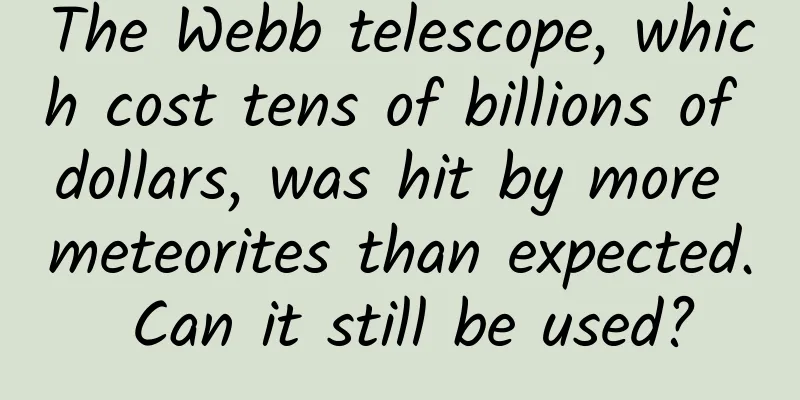The Webb telescope, which cost tens of billions of dollars, was hit by more meteorites than expected. Can it still be used?

|
The James Webb Space Telescope (hereinafter referred to as "Webb"), which cost tens of billions of dollars and was repeatedly delayed in its launch, took more than 20 years of research and development and manufacturing, and was finally launched on December 25, 2021. After more than a month of long journey, "Webb" arrived at the second Lagrange point 1.5 million kilometers from the earth, where it will stay at its post to complete its 10-year observation service mission. Soon, Webb sent back a photo of the lens being debugged. NASA (the abbreviation of the National Aeronautics and Space Administration) announced that the photo was clear and everything was fine, and that the mission would begin soon. Unexpectedly, before the mission began, Webb was hit by a micrometeorite between May 23 and May 25. You know, the reason why the Webb has been delayed again and again is to keep improving its performance. Because the Webb is not like its predecessor, the Hubble Space Telescope (hereinafter referred to as "Hubble"), which only works in low-Earth orbit, astronauts can be sent to adjust and repair it if there is any problem. In fact, NASA has sent space shuttles and astronauts to Hubble's orbit many times to adjust and repair it, which enabled Hubble to make many astonishing discoveries about the universe and take countless gorgeous and bizarre photos of celestial bodies, greatly enriching human understanding of the universe. Webb is located far from the Earth, nearly four times the distance from the Moon. If a problem occurs, astronauts cannot be sent to adjust and repair it, and it can only be scrapped. In this way, the $10 billion investment will be wasted, and the decades of research and development efforts of the huge scientific and technological team will also be wasted. This is a one-time deal, so of course they would be extremely cautious and strive for perfection, which is why the launch was postponed many times and finally launched after more than 20 years. However, the space environment is uncontrollable, and meteorite impact is one of the possible damages that has been estimated long ago. Space is too vast, and the chances of being hit by a large meteorite are extremely small. If it is hit, it will be scrapped. There is nothing that can be done about it. However, the chances of being hit by a micrometeorite are higher, so the Weber's ability to resist micrometeorite impacts was taken into consideration during its design. Before the spacecraft was officially launched, engineers also conducted a special test. What is a micrometeorite? It is a cosmic dust particle smaller than 1 mm. So how big is the micrometeorite that hit Webb? According to a news release from NASA, the particle that hit Webb was a "dust-sized particle flying at an extremely high speed" that was larger than the engineers expected in their tests, but the specific size was not announced. But it can be seen that the impact caused damage. NASA claims that engineers have already made adjustments to the affected locations, and this operation will become a routine part of monitoring and maintenance throughout the mission. Paul Geithner, deputy project manager for technology at NASA's Goddard Space Flight Center, said that the space environment that Webb will need to deal with was taken into account during its design, including strong ultraviolet rays and charged particles from the sun, cosmic rays from the Milky Way, and occasional impacts from micrometeorites within the solar system. Previously, NASA announced that Webb will deliver its first full-color scientific image on July 12. Will this micrometeorite attack affect the implementation of this mission? NASA's answer is no, because Webb was over-designed before it went into space, which means that there is enough performance margin. Even if it is hit by a micrometeorite, Webb can sense and adjust the position of the mirror and automatically correct the distortion caused by the impact. Moreover, ground engineers also support this adjustment. On March 16, the Webb science team released a picture of a bright star named 2MASS J17554042+6551277, claiming that this picture is no longer a composite, but a single image of the star taken by all the lenses working together. However, this picture still has long starbursts. So what kind of surprise will there be on July 12? Let's wait and see. Further reading: "Weber" basic parameters and performance (reference): The James Webb Space Telescope (JWST) is an infrared observation space telescope jointly developed by NASA, the European Space Agency and the Canadian Aerospace Agency. It is the successor to the Hubble Space Telescope. The James Webb Space Telescope has a mass of 6.2 tons, about half that of the Hubble Space Telescope (11 tons). The primary reflector is made of beryllium, with a diameter of 6.5 meters and an area more than five times that of the Hubble Space Telescope. It can also operate in the near-infrared band and in an environment close to absolute zero (equivalent to minus 273.15 degrees Celsius). In mid-July 2022, the James Webb Space Telescope will officially start construction and take the first batch of photos for scientific research. The main mission of the James Webb Space Telescope is to investigate the residual infrared evidence (cosmic microwave background radiation) of the Big Bang theory, that is, to observe the early state of the universe visible today. To achieve this goal, it is equipped with high-sensitivity infrared sensors, spectrometers, etc. To facilitate observation, the body must be able to withstand extremely low temperatures and avoid the light of the sun and the earth. For this reason, the James Webb Space Telescope comes with a foldable sunshade to shield light sources that may interfere. Because it is located at the Lagrange point, the earth and the sun are always in the same relative position in the telescope's field of view, and the sunshade can be effective without frequent position corrections. Some people describe the Hubble telescope's "Dharma Eye" as being able to capture a firefly 16,000 kilometers away, and the Webb's observation capability is 100 times greater than that of the Hubble. So how far does this firefly have to be to escape the palm of this "Buddha"? In addition, "Webb" not only has the optical performance of "Hubble", but also has full-band infrared observation capabilities. That is to say, Hubble can only see celestial bodies that emit visible light, while Webb can not only observe visible light, but also invisible light. Any celestial body, as long as it is above absolute zero, will emit infrared rays. This capability can also observe through the obstruction of cosmic dust. NASA calls Webb a "time machine" that uses infrared observations, which means that it can observe back to the earliest infant universe. In theory, it can observe 13.8 billion light-years away, when the universe just emitted its first light. The most important task of "Webb" is to observe the earliest states of the Big Bang and to search for signs of life on exoplanets. Welcome to discuss, thanks for reading. The copyright of Space-Time Communication is original. Please do not infringe or plagiarize. Thank you for your understanding and cooperation. |
<<: Why can't I help but want to rub it when I see something cute?
>>: Why do humans have to wipe their butts but animals don't?
Recommend
APP promotion: This should be the most complete ground promotion plan!
APP promotion online promotion is important, but ...
WeChat always takes up a lot of memory. Don't clean it up randomly. These four tips are the most practical.
The most painful thing is that WeChat records can...
Unleashing Human Potential: The AI Skills Revolution
The world has entered an era of intelligence driv...
Down jackets don't actually contain "down"? The police took action! One picture shows how to distinguish true from false
“No need for 998, no need for 198!” “Down jacket ...
A 10,000-word article deconstructs the logic of the e-commerce live streaming industry
Live broadcast, live broadcast, live broadcast......
Why can’t I stop staying up late?
Good sleep, healthy companion. What to do if you ...
Are your eyes afraid of the cold? Tears keep flowing when the wind blows in winter
Audit expert: Liu Dongbao Chief Physician of Opht...
"Zero-carbon agricultural products": Ding! Please check your "new green menu"
Organic food, also known as ecological or biologi...
Longer term trends of the top 10 programming languages ranking (1989-2014)
IOBE has just released the November programming l...
Li Ziqi had a severe allergic reaction while filming a video, and felt uncomfortable all over! Why is she allergic to paint?
Audit expert: Peng Guoqiu Deputy Chief Physician,...
47! The first batch of national civilized tourism demonstration units are here
On November 18, the National Tourism Standardizat...
Practical tips on field marketing cases: How do you spend the first hour in the field marketing battlefield?
16 years ago, Alibaba relied on a huge field sale...
Nanny-level tutorial on Tik Tok marketing!
Today I bring you a nanny-level teaching course o...
Multi-dimensional analysis of the trend of the "deep learning" market
[[192373]] Industry Analysis In 2016, the global ...









